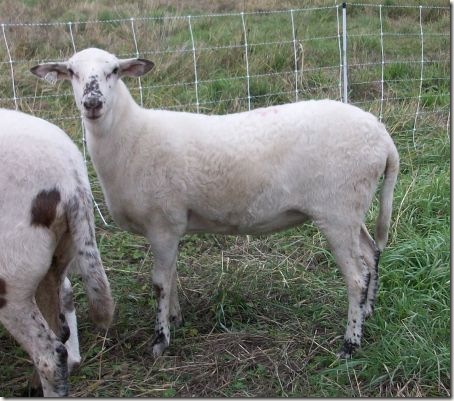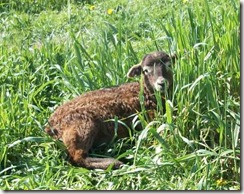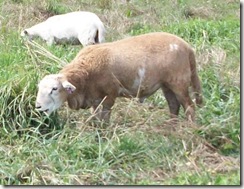 Ok, I have notes from three more speakers I heard at the KHSI Expo in Corvallis. Dr. Jim Miller addressed parasite control; he is from the Veterinary Medical School at Louisiana State University. He is also one of the founders of the Southern Consortium for Small Ruminant Parasite Control.
Ok, I have notes from three more speakers I heard at the KHSI Expo in Corvallis. Dr. Jim Miller addressed parasite control; he is from the Veterinary Medical School at Louisiana State University. He is also one of the founders of the Southern Consortium for Small Ruminant Parasite Control.
Category: Sheep
OPPV News at the KHSI Expo
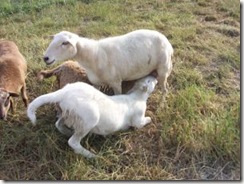 I still have more notes to share from the KHSI Expo! Another speaker we heard from was Dr. Lynn Hermann-Hoesing, from the USDA-ARS-Animal Disease Research Unit at Washington State University. Her team is doing research on Ovine Progressive Pneumonia Virus, or OPPV. It is a costly disease that is likened to AIDS in humans- slowly progressive, it robs ewes of thriftiness, and eventually leads to premature death.
I still have more notes to share from the KHSI Expo! Another speaker we heard from was Dr. Lynn Hermann-Hoesing, from the USDA-ARS-Animal Disease Research Unit at Washington State University. Her team is doing research on Ovine Progressive Pneumonia Virus, or OPPV. It is a costly disease that is likened to AIDS in humans- slowly progressive, it robs ewes of thriftiness, and eventually leads to premature death.
One in five sheep in the U.S. are infected, and one in three on the open range. There is correlation to flock size, larger flocks have a higher incidence of OPPV. It is estimated that OPPV costs the sheep industry about $2.7 million annually in lost productivity. The problem with OPPV is that it is often not overtly noticeable to the shepherd, but a flock will experience a smaller, less healthy lamb crop, and ewes that do not live a normal life span. So, the disease is of grave concern to the industry, and is often referred to as the “silent thief.”
New Ewes
At the Katahdin Hair Sheep International Expo in Oregon, they held an auction-style sale. This was a great opportunity to purchase some sheep that are from different bloodlines than the ones we have commonly in our area. It would have been ideal to purchase a ram there, but since I already have two rams that I can use for the next couple of years, it didn’t seem justified getting a third one for my small flock. So, I went with the intention of getting some ewes at least, to diversify the genetics I have.
Last KHSI Notes on Grass: RCG in the Northwest
My last bit of learning from Woody Lane’s class on grass actually happened at the lunch table. I had the good fortune of sitting by him, so got another whole hour of his knowledge! The topic of discussion was of great interest to me: reed canary grass (RCG), because we have a lot of it. The above picture is what our RCG looked like when we first started to tackle it, during the winter, it would lay in dead layers of brown like this. Beyond it, you can see a field of more “normal” green pasture grass that had been well-maintained by the prior property owner, cut for cow silage multiple times per season.
Continue reading “Last KHSI Notes on Grass: RCG in the Northwest”
What I Learned About Grass at the KHSI Expo: Part IV
Here is the fourth section of my notes on grass. Needless to say, I took a LOT of notes during Woody Lane’s lecture…
Continue reading “What I Learned About Grass at the KHSI Expo: Part IV”
What I Learned About Grass at the KHSI Expo: Part III
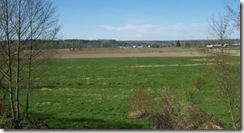 Here’s the third part of my notes from Woody Lane’s lecture on grass. This is intuitive once you say it and graph it; but grass, when it first starts growing, has the highest nutritional content it’s going to get. It’s TDN (total digestible nutrients) at this stage is likely in the low 70’s, percentage-wise. As it grows, it increases in volume, of course, but it also starts to decrease in TDN. When it’s headed out to seed, its TDN is down around 45%. So, there is an inverse relationship there, between increasing volume and decreasing nutritional value.
Here’s the third part of my notes from Woody Lane’s lecture on grass. This is intuitive once you say it and graph it; but grass, when it first starts growing, has the highest nutritional content it’s going to get. It’s TDN (total digestible nutrients) at this stage is likely in the low 70’s, percentage-wise. As it grows, it increases in volume, of course, but it also starts to decrease in TDN. When it’s headed out to seed, its TDN is down around 45%. So, there is an inverse relationship there, between increasing volume and decreasing nutritional value.
Continue reading “What I Learned About Grass at the KHSI Expo: Part III”
What I Learned About Grass at the KHSI Expo: Part II
 Here is a next bit of my notes from Woody Lane’s lecture on grass and nutrition. First, I should offer the caveat that he gave, which was that he felt he had to oversimplify some technical terms, due to the time constraints of the 2-hour class (which he normally teaches over several weeks). And, a second caveat that if something seems wonky in the information, surely it is my note-taking, and not Woody’s information, which is incorrect. 😉 Comments are welcome if I’ve gotten something wrong.
Here is a next bit of my notes from Woody Lane’s lecture on grass and nutrition. First, I should offer the caveat that he gave, which was that he felt he had to oversimplify some technical terms, due to the time constraints of the 2-hour class (which he normally teaches over several weeks). And, a second caveat that if something seems wonky in the information, surely it is my note-taking, and not Woody’s information, which is incorrect. 😉 Comments are welcome if I’ve gotten something wrong.
Woody introduced two terms which are important in considering what grazing animals need to eat in order to grow.
Continue reading “What I Learned About Grass at the KHSI Expo: Part II”
What I Learned About Grass at the KHSI Expo: Part I
 I’m not sure if I can say which speaker had the most exciting information at The Expo, there were several highlights. But this was one of the top ones for me: Dr. Woody Lane’s two-hour discussion on pasture management and grass. Dr. Lane owns and operates Lane’s Livestock Services, a consulting firm. (I couldn’t find a website to which I could link…). And, everyone seems to just call him Woody. He lives in Roseburg, OR, and frequently teaches a very extensive animal nutrition course in that area.
I’m not sure if I can say which speaker had the most exciting information at The Expo, there were several highlights. But this was one of the top ones for me: Dr. Woody Lane’s two-hour discussion on pasture management and grass. Dr. Lane owns and operates Lane’s Livestock Services, a consulting firm. (I couldn’t find a website to which I could link…). And, everyone seems to just call him Woody. He lives in Roseburg, OR, and frequently teaches a very extensive animal nutrition course in that area.
Woody is an engaging and animated speaker, started out his talk with these fightin’ words: “Pasture rotation doesn’t work.” :-0 Continue reading “What I Learned About Grass at the KHSI Expo: Part I”
Sheep Summer Camp: The Ferry and OSU
During the first day of the KHSI Expo, we toured three different facilities. There were maybe fifty people attending the tours, so we all shared rides. I jumped in with a nice fellow named Chuck, who chauffeured me and three other people through the day’s tours. Chuck had a GPS system, and I was comparing its instructions to the printed driving directions we were given. On our way to one of the tours, the GPS started taking us in a completely different route than what the paper directions said. We had a moment of indecision, then unanimously agreed to rely on the technology to get us there. But, I was momentarily distressed to hear Ms. GPS Voice say “turn right and board ferry.” Ferry!?!
More: Sheep Summer Camp Fun and Learning
The second stop of the KHSI Expo learning experience was to tour Jo-Le Farms in Scio, Oregon. Jon and Leslie Carter have been raising commercial Coopworth sheep for many years, and decided to “breed the wool off” their sheep in 1999 when Jon started having back problems and no longer wanted to shear. Jon used mainly Dorper and White Dorper genetics to do this, but recently has been experimenting with Wiltshire Horn terminal sire influence as well. (More history on that endeavor is on their blog.)
